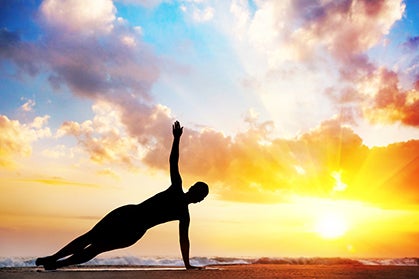5 Exercises for a Stronger Core

Build stamina and reduce injuries by devoting a few minutes each day to this simple workout routine
Bigstock Photo
Athletes everywhere seek the ideal body of firm defined legs and toned abs. Dr. Michael Fredericson and other researchers from Stanford University School of Medicine found that this outward appearance of fitness is not enough to produce the power necessary to sustain high performance in running. They suggest a core-training program to build a power center capable of propelling the body without losing energy.
Stamina is the ability to sustain prolonged physical effort. As we run, our muscles tire, and our running mechanics begin to falter. Our upper body begins to sway, our legs refuse to lift, and our back begins to ache. Just as we reach the final push in our run, our body begins to fatigue.
The Core
The “core” houses more than 20 muscles and includes the following categories: low-back stabilizers, lateral stabilizers (obliques), abdominals, hip flexors and hip extensors (gluteal muscles and hamstrings). These muscles provide power and stabilization for human movement, and proper conditioning increases efficiency in our running motion.
The core is fundamental in stabilizing the upper body so the force can flow smoothly with the body. Like a sports car with tight shocks, a runner’s body with a tight core will seamlessly transfer energy from the ground up.
Strengthening the Core
During running, the low back stabilizers, lateral stabilizers, and abdominals function almost exclusively to maintain the position of the upper body. When the trail turns or is uneven, a stable upper body is more energy efficient than a lax upper body. To strengthen these muscles, we put them in a position that forces the muscle groups to fire to maintain an ideal position.
The hip extensors and hip flexors also provide stabilization for runners. However, they also contract through a large range of motion to provide power during running. For these muscle groups, we will use dynamic exercises, forcing the muscles to exert force in a running-type motion.
The Core Workout
1. Bridge (Low-Back Stabilizers, Hip Extensors)
- Begin by lying on your back with your knees bent so that the knees are directly above the feet. Activate the abdominals and squeeze the gluteals to lift the pelvis off the ground while keeping your back straight. Your pelvis should rise to align with your knees and shoulders. Hold for 3-5 seconds. Relax for 1-2 seconds. Repeat for 2-3 minutes.
- For more of a challenge, put your feet on the edge of a bed or physioball with knees extended.
2. Plank (Abdominals, Hip Flexors)
- Begin by lying on your stomach with your elbows under your shoulders. Activate the abdominals and push down with your elbows to lift your body off the ground. Your body should be off the ground staying straight like a plank. Hold for 3-5 seconds. Relax for 1-2 seconds. Repeat for 2-3 minutes.
- For more of a challenge put your feet or hands on a physioball.
3. Side Plank (Lateral Stabilizers)
- The side plank is performed the same was as the plank except now you are on your side, resting only on one elbow and the side of one foot. Make sure your body is straight and now bending in the middle. Hold for 3-5 seconds. Relax for 1-2 seconds. Repeat for 1-2 minutes. Switch sides and repeat.
4. Hamstring Curls with Physioball (Hip Extensors, Low Back Stabilizers)
- Begin by lying on your back with you feet propped on the physioball with your knees extended. Activate your abdominals and lift your pelvis to bring your body into a straight line. While keeping your body straight, curl your feet as far as you can. In a controlled manner, straighten your legs to the beginning position. Perform 3 sets of 8-10 curls.
5. Physioball Squat Thrust (Hip Flexors, Abdominals)
- Begin with your hands in push-up position and your shins resting on the physioball. Pull your knees to your chest as far as you can. In a controlled manner, straighten your legs to the beginning position. Perform 3 sets of 8-10.
Asael Checketts recently graduated from BYU with a degree in Athletic Training. He competes in half marathons and other recreational sports.